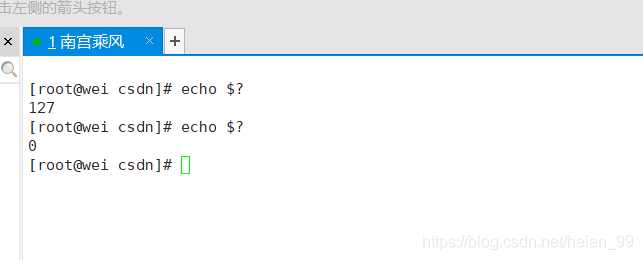Shell 是一个用 C 语言编写的程序,它是用户使用 Linux 的桥梁。Shell 既是一种命令语言,又是一种程序设计语言。
Shell 是指一种应用程序,这个应用程序提供了一个界面,用户通过这个界面访问操作系统内核的服务。
Ken Thompson 的 sh 是第一种 Unix Shell,Windows Explorer 是一个典型的图形界面 Shell。
Shell 脚本
Shell 脚本(shell script),是一种为 shell 编写的脚本程序。
业界所说的 shell 通常都是指 shell 脚本,但读者朋友要知道,shell 和 shell script 是两个不同的概念。
SHELL 变量
变量(内存空间)
增加脚本的灵活性,适用性
类型:
自定义变量
环境变量(Path)
特殊变量
自定义变量
变量名称规范:
- 命名只能使用英文字母,数字和下划线,首个字符不能以数字开头。
- 中间不能有空格,可以使用下划线(_)。
- 不能使用标点符号。
- 不能使用bash里的关键字(可用help命令查看保留关键字)。
1 声明变量
# 变量名称=变量值
[root@wei csdn]# name=wei
2 调用变量的值
$变量名称
${变量名称} 变量名称或紧跟数字,字符的时候
输出时,由变量名,必须用双引号
[root@wei csdn]# name=cat
[root@wei csdn]# echo "this is $name"
this is cat
[root@wei csdn]# echo "this is ${name}"
this is cat
[root@wei csdn]# echo "this is ${name}s"
this is cats3 SHELL变量的值默认全做为字符处理
[root@wei csdn]# a=10
[root@wei csdn]# b=20
[root@wei csdn]# c=a+b
[root@wei csdn]# echo $c
a+b
[root@wei csdn]# a=10
[root@wei csdn]# b=20
[root@wei csdn]# c=$a+$b
[root@wei csdn]# echo $c
10+20数学运算:
方法1:$(())
[root@wei csdn]# a=10
[root@wei csdn]# b=20
[root@wei csdn]# c=$((a+b))
[root@wei csdn]# echo $c
30方法2:关键字:let
[root@wei csdn]# a=10
[root@wei csdn]# b=20
[root@wei csdn]# let c=a+b
[root@wei csdn]# echo $c
30方法3:关键字:declare
[root@wei csdn]# a=10
[root@wei csdn]# b=20
[root@wei csdn]# declare -i c=a+b
[root@wei csdn]# echo $c
30数学运算符:
+
-
*
/ 整除
% 取余
生成随机数
[root@wei csdn]# echo $RANDOM
11400
[root@wei csdn]# echo $RANDOM
9702
[root@wei csdn]# echo $RANDOM
21328生成10以内的随机数:
[root@wei csdn]# echo $((RANDOM%10))
4
[root@wei csdn]# echo $((RANDOM%10))
2
4 命令引用
反引号 `COMMAND`
$(COMMAND)
[root@wei csdn]# a=`ls -ldh /etc/`
[root@wei csdn]# echo $a
drwxr-xr-x. 77 root root 8.0K 3月 14 16:23 /etc/
[root@wei csdn]# b=$(ls -ldh /etc/)
[root@wei csdn]# echo $b
drwxr-xr-x. 77 root root 8.0K 3月 14 16:23 /etc/提取ip
[root@wei csdn]# ifconfig ens33 |grep "netmask" | awk '{print $2}'
192.168.196.131[root@wei csdn]# head -n 3 /etc/passwd |awk -F: '{print $1,$6,$7}'
root /root /bin/bash
bin /bin /sbin/nologin
daemon /sbin /sbin/nologin
5 删除变量
# unset 变量名称
环境变量
(1)查看环境变量
[root@wei csdn]# env | less(2)定义环境变量:修改环境变量的值
#export 变量名称=变量值
[root@wei csdn]# vim /etc/profile
[root@wei csdn]# source /etc/profile
$?判断上个命令的执行状态(0--255)
0:代表成功
其余:代表失败
